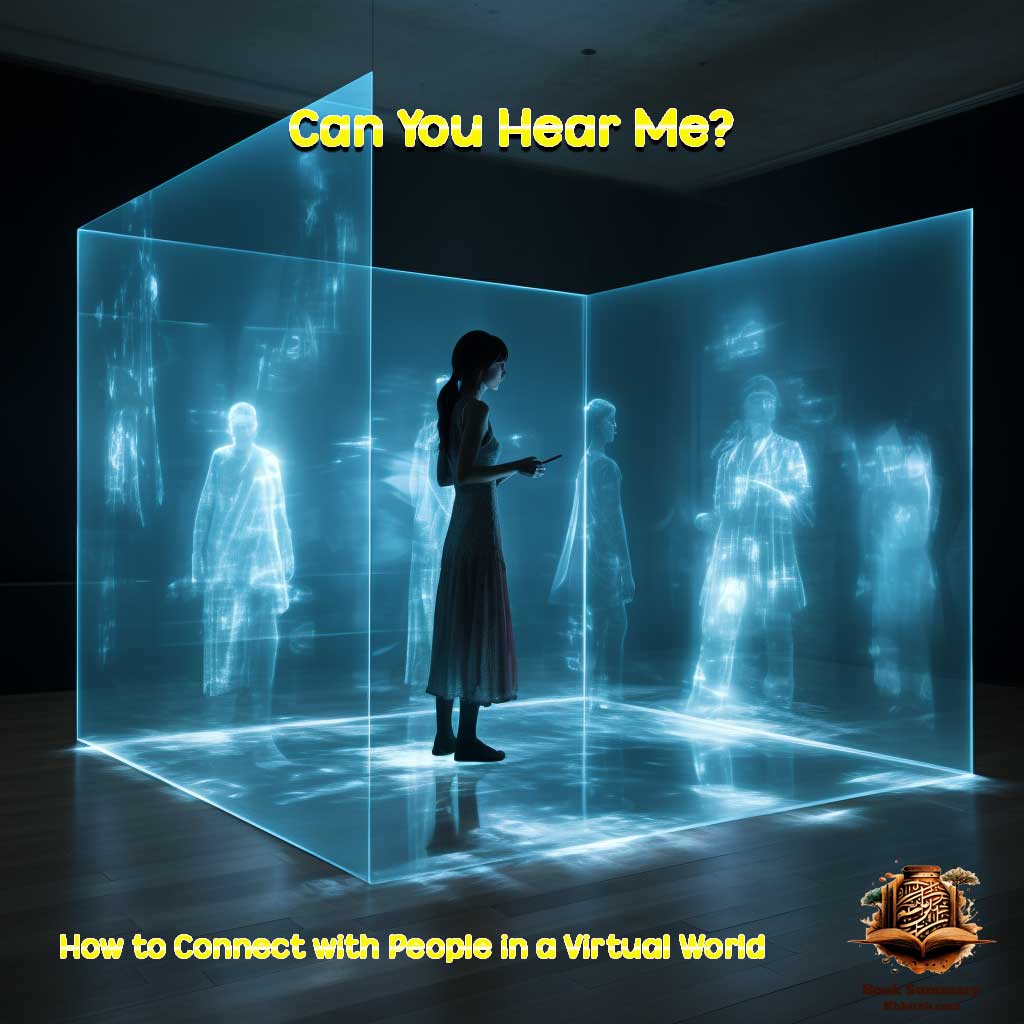Can You Hear Me?: How to Connect with People in a Virtual World Book Summary

In an ever-expanding digital landscape, we find ourselves immersed in a technological wave that has revolutionized how we connect. “Can You Hear Me?: How to Connect with People in a Virtual World” sheds light on the challenges and nuances of this digital communication era.
Humans have always sought connection and interaction. With rapid technological advancements, we now have novel tools to communicate and engage. But do these tools truly deliver on their promise? Or do they exacerbate the distance between us, making our interactions more superficial and less meaningful?
This book offers a profound examination of the disparities between digital communication and face-to-face interactions. It seeks to aid us in understanding the hurdles we face in the digital communication realm and how we can navigate them to achieve more genuine, deeper human connections.
Table of Contents
Is Technology Bringing Us Closer or Pushing Us Apart? Exploring the Digital Paradox
In the age of rapid technological advancement, the book “Can You Hear Me?: How to Connect with People in a Virtual World” delves deeply into the intriguing conundrum of the digital paradox. While our world has become a global village, connecting people across continents in mere seconds, a peculiar sentiment of isolation persists. Why is it that in an era where we are ostensibly more connected than any time in human history, many of us still feel a profound sense of disconnection?
Digital platforms, from social media networks to professional communication tools, promise instant connectivity. We’re told we can maintain friendships, forge new relationships, and even sustain romantic connections, all with the click of a button. Yet, the reality is often starkly different. While we can reach out and ‘connect’ with hundreds or even thousands of individuals online, the depth and quality of these connections are frequently put to question.
Consider the traditional forms of communication: a face-to-face conversation, where body language, intonation, and physical presence play pivotal roles. These non-verbal cues, often taken for granted, are lost in the realm of digital communication. The absence of these cues can lead to misunderstandings and even create feelings of detachment. Furthermore, the sheer volume of digital interactions can become overwhelming, leading individuals to prefer quantity over quality.
The book underscores the importance of understanding this digital paradox. Recognizing the limitations of online communication is the first step towards bridging the gap between our online personas and our real-world selves. Only by acknowledging the dichotomy can we take proactive measures to ensure that our digital interactions are as genuine, fulfilling, and deep as our face-to-face ones.
In conclusion, while the digital age offers unprecedented opportunities for global connectivity, it also poses unique challenges. “Can You Hear Me?” prompts readers to introspect on their digital relationships and to seek ways to make their online interactions more meaningful, authentic, and emotionally fulfilling.
Philosophy and Sociology – Book Summary (khkitab.com)
How Do We Navigate the Silence? Understanding the Absence of Non-verbal Cues in Digital Communication from Can You Hear Me?
In the transformative realm of digital communication, the book “Can You Hear Me?: How to Connect with People in a Virtual World” sheds light on a pressing concern: the loss of non-verbal cues. With the majority of our interactions transitioning online, from professional meetings to personal conversations, we often find ourselves navigating the digital landscape without the traditional compass of body language, facial expressions, and tone variations.
Human beings have, for millennia, depended on these non-verbal signals to decipher intent, gauge emotions, and build rapport. A simple nod, a smile, or even a pause in a conversation can convey volumes. In the virtual world, however, these signals become absent or distorted. While emojis and GIFs attempt to fill this void, they often fall short of replicating the nuances and depth of real-life interactions.
This absence not only complicates our digital interactions but also intensifies the potential for misunderstandings. How often have we misinterpreted a text message because it lacked the intended tone? Or felt uncertain during a video call because we couldn’t gauge the other person’s true feelings or reactions? The digital space, with its vast potential, also presents a unique challenge: communication without the comfort and clarity of non-verbal cues.
Recognizing this challenge, “Can You Hear Me?” emphasizes the need for augmented awareness when engaging online. By being more intentional in our written and verbal communication, by using descriptive language, and by frequently checking in with our counterparts for clarity, we can attempt to bridge the gap. Yet, it also prompts a reflection on the evolving nature of communication and the tools we might develop in the future to better mimic the richness of face-to-face interactions.
In essence, as the digital age propels us into a new era of communication, understanding the profound impact of missing non-verbal cues becomes paramount. It’s a journey of learning, adapting, and, most importantly, understanding the silent signals in the noisy virtual world.
Our Facebook Page – Book Summary
How Does Our Brain Distinguish Between Digital and Face-to-Face Interactions? From Can You Hear Me?
In the realm of communication, “Can You Hear Me?: How to Connect with People in a Virtual World” delves deep into an often overlooked dimension: the neurological processes that power our interactions. When it comes to digital versus face-to-face communication, our brain’s mechanism of understanding, interpreting, and responding to signals changes dramatically.
At its core, face-to-face interaction has been the cornerstone of human communication for millennia. Here, our brains are primed to pick up on subtle nuances, from the faintest change in tone to the slightest twitch of an eyebrow. These immediate sensory inputs are processed rapidly, allowing us to gauge emotions, intentions, and even potential threats or opportunities. This multisensory engagement – hearing a voice, seeing facial expressions, feeling the energy in the room – creates a holistic understanding of the interaction, deeply rooted in our evolutionary past.
In contrast, digital communication often strips away these layers of nuance. Text-based interactions, for instance, lack auditory and visual cues. Even video calls, though visually inclusive, might miss out on many unspoken cues due to lag, video quality, or just the limitations of screen dimensions. Consequently, our brains work overtime to fill in the gaps. We may overanalyze a message, infer tones that weren’t intended, or miss sarcasm and humor entirely. The absence of direct multisensory engagement means that our brain often relies on past experiences, biases, or assumptions to interpret digital interactions, making the process more prone to misunderstandings.
The book underscores the importance of recognizing these distinct brain processes in different communication settings. As more of our interactions shift online, being aware of these neurological shifts can be pivotal in fostering effective communication. Adapting our digital communication strategies, being more explicit, seeking clarifications, and utilizing tools that offer richer sensory experiences can help bridge the cognitive gap.
In conclusion, “Can You Hear Me?” highlights a profound yet understated aspect of our digital age: the interplay between technology and our brain’s innate mechanisms of communication. It invites readers to understand, adapt, and master the art of connection, irrespective of the medium.
Misunderstandings in the Digital Realm: How Do Absent Tonal and Facial Cues Impact Our Online Interactions? from Can You Hear Me?
The digital revolution, while bridging geographical divides, has introduced an array of communication challenges. “Can You Hear Me?: How to Connect with People in a Virtual World” delves into the nuances of digital interactions, highlighting the integral role of non-verbal cues in human communication, and how their absence in virtual exchanges can often lead to misunderstandings.
Traditionally, face-to-face interactions enabled us to pick up on a wide spectrum of non-verbal cues: the inflections in a person’s voice, their facial expressions, their body language, and even the pauses between their words. Each of these cues carried a wealth of information, helping to add depth, context, and clarity to the spoken word. They are the subtle hints that allow us to gauge emotions, detect sarcasm, or even discern when someone is not being entirely truthful.
However, as the book aptly points out, digital communication – especially text-based exchanges like emails and chats – strips away these invaluable tonal and facial cues. Imagine receiving a message saying, “That’s fine.” Without the accompanying tone or facial expression, the actual intent behind that message becomes nebulous. Is it genuinely fine, or is it a passive-aggressive remark?
Moreover, this absence forces our brains to fill in the blanks, often relying on our biases, mood, or previous experiences. This compensatory mechanism, while natural, can easily skew our perception, leading us to misinterpret the sender’s intent. For instance, a straightforward request can be perceived as an aggressive demand, or a joke can be taken as an offensive remark, all due to the lack of tonal and facial context.
“Can You Hear Me?” serves as a guide for navigating this new communication landscape. It underscores the importance of being more explicit in our digital exchanges and encourages readers to employ tools like emojis, GIFs, or even voice notes – anything that can help recreate some semblance of those missing non-verbal cues.
In conclusion, as our world becomes increasingly virtual, understanding the pitfalls and potential of digital communication becomes paramount. The essence of the book revolves around the idea that to connect effectively in a virtual world, we must not only communicate our thoughts but also understand and overcome the inherent limitations of digital platforms.
Emotions and Technology: How Are Feelings Misconstrued in Digital Communications? from Can You Hear Me?
In the digital era, the book “Can You Hear Me?: How to Connect with People in a Virtual World” delves deep into the intricate realm of virtual communication and the unique challenges it brings. A central theme is the conveyance and misinterpretation of emotions in a digital space.
Emotions play a pivotal role in human interactions, guiding our reactions, decisions, and perceptions. When conversing face-to-face, we rely on a vast array of non-verbal cues, like facial expressions, tone, body language, and even the pace of speech. These cues give context, adding layers of meaning to our words. They let us know if a jest is playful or sarcastic, or if a statement is made in anger or jest.
However, digital communication often strips away these essential cues. Think about it: How many times have we read a text or an email and wondered about the sender’s tone? Is that “Okay” in a message a genuine acknowledgment or a passive-aggressive remark? In the absence of tonal and facial cues, the risk of misinterpreting emotions escalates.
The book also points out the tools that digital platforms offer to mitigate these issues. Emojis, GIFs, and voice notes have emerged as digital equivalents of emotional cues. Yet, they too have limitations and can be misunderstood. For instance, the same emoji might be perceived differently across cultures or age groups.
“Can You Hear Me?” emphasizes the importance of being explicit in our digital communications. It’s beneficial to sometimes take an extra moment to clarify our sentiments, ensuring the recipient understands our true intent. This might mean using more descriptive words, sending a voice note for clarity, or occasionally picking up the phone for a traditional call when emotions run high.
In summary, while technology offers unprecedented ways to connect, it also presents new challenges in conveying emotions accurately. Recognizing these challenges and adapting our communication strategies is crucial for maintaining meaningful and effective digital interactions.
The Role of Emojis and Digital Shorthand: Do They Truly Bridge the Communication Gap in the Digital Era? from Can You Hear Me?
In today’s digital age, where communication predominantly occurs through screens, one of the profound challenges is the transmission of emotion, tone, and intent. “Can You Hear Me?: How to Connect with People in a Virtual World” dives deep into the intricacies and nuances of this modern communication dilemma. One of the pivotal topics discussed is the rise and significance of emojis and digital shorthand.
Emojis, those colorful little icons we often append to our messages, have burgeoned into the fabric of our online conversations. They serve as an attempt to inject emotion, humor, or emphasis where plain text may fall short. A smiling face can turn a seemingly curt message into a friendly note. A thumbs up can quickly signify agreement or approval. In a sense, emojis have become our digital era’s version of non-verbal cues.
But as much as they offer benefits, emojis also come with limitations. Their meanings can be ambiguous. What’s cheerful to one person might come off as sarcastic to another. And, cultural differences can further muddy the waters. An emoji interpreted in one way in a particular culture might mean something entirely different in another.
Digital shorthand, on the other hand, like “LOL,” “BRB,” or “TTYL,” provides concise ways to convey longer thoughts or statuses. These shorthands expedite communication, especially in a fast-paced world. However, the potential for misunderstanding is immense if the recipient isn’t familiar with the abbreviation.
Moreover, the over-reliance on such digital tools might lead to an erosion of richer, more in-depth communication. When we default to emojis or shorthand, we might be missing out on the depth and breadth of human connection that comes with fuller expression.
“Can You Hear Me?” emphasizes the balance. While emojis and digital shorthand can be powerful tools to enhance our online communication, they shouldn’t replace the genuine, thoughtful exchanges that build stronger connections. It’s essential to recognize when a quick emoji suffices and when a more in-depth conversation is warranted.
In conclusion, while the digital landscape has certainly changed the way we communicate, it’s crucial to use the tools at our disposal wisely. Emojis and digital shorthand, though beneficial, are not panaceas. They come with their set of challenges. The key lies in understanding their strengths, recognizing their limitations, and applying them judiciously to foster effective digital communication.
Strategies for Effective Digital Communication: Can We Truly Replicate In-Person Interactions Online? from Can You Hear Me?
In the age of technology, where most of our conversations are happening behind screens, ensuring effective digital communication becomes paramount. Nick Morgan’s book, “Can You Hear Me?: How to Connect with People in a Virtual World,” delves deep into this topic, exploring the inherent challenges and offering solutions.
- Embrace Clarity Over Brevity: Unlike face-to-face conversations where body language can fill in gaps, online conversations don’t have that luxury. It’s essential to be clear, even if it means using a few extra words. Clear communication reduces chances for misunderstandings.
- Harness the Power of Emojis Sparingly: Emojis can help convey emotion, tone, or intent, but they also come with limitations. They can mean different things in different cultures and can sometimes introduce ambiguity. They’re a great tool, but they shouldn’t be the primary mode of conveying serious emotions or thoughts.
- Periodic Audio or Video Check-ins: Text-based communication can lack warmth and human connection. By integrating occasional video or audio calls, we introduce the nuances of voice modulation, facial expressions, and tone that text fails to capture.
- Practice Active Listening: This principle of effective communication isn’t limited to face-to-face interactions. In digital realms, it’s even more important. This means reading messages carefully, asking clarifying questions if something is unclear, and providing feedback to let the other party know they’ve been understood.
- Avoid Overloading Information: In a virtual world, it’s easy to send long, dense paragraphs of information. However, breaking messages down, using bullet points, or sending information in smaller chunks can help in retaining attention and ensuring comprehension.
- Be Mindful of Time Zones and Cultural Differences: The virtual world is often without borders. Recognizing and respecting differences, whether it’s sending messages at an appropriate time or being sensitive to cultural nuances, goes a long way in fostering effective communication.
- Feedback is Crucial: Regularly asking for feedback and being open to receiving it ensures that any gaps in digital communication are identified and bridged promptly.
In conclusion, while the digital realm poses unique challenges, with the right strategies, it’s possible to make our online interactions as effective, if not more so, than face-to-face conversations. Morgan’s book provides invaluable insights into navigating this terrain, ensuring that even in a world dominated by screens, genuine human connection is not lost.
Do Video Calls Truly Enhance the Quality of Communication Over Traditional Calls? from Can You Hear Me?
In the digital age, the emergence of video calls has changed the dynamics of how we communicate. But do they genuinely improve the quality of our interactions? Nick Morgan’s book, “Can You Hear Me?: How to Connect with People in a Virtual World,” delves into the intricacies of virtual communication and offers insights that shed light on this very question.
- Non-verbal Cues: One of the most significant advantages of video calls is the inclusion of non-verbal communication. Being able to see a person’s facial expressions, gestures, and posture can enrich the conversation and convey feelings and emotions that might be missed in a traditional call.
- Engagement Levels: Video calls tend to promote higher engagement levels. When you can see the other person, it becomes harder to multitask, leading to more focused and attentive conversations.
- Technical Issues: On the flip side, video calls can sometimes be hampered by technical glitches. Poor internet connection, lag, or camera issues can disrupt the flow of conversation, potentially making traditional calls a smoother option.
- Intensity of Connection: While video calls offer a visual connection, they can sometimes be draining, especially when multiple calls are lined up in a day. Traditional calls, without the constant need for visual engagement, can be less exhausting.
- Professionalism and Environment: Video calls require a suitable background, decent lighting, and appropriate attire, at least from the waist up. Traditional calls, being audio-only, relieve this pressure and allow for a more flexible environment.
- Accessibility: Not everyone has access to stable internet connections and high-quality cameras. In these cases, traditional calls can be more inclusive, ensuring that everyone can participate without technical hindrances.
- Learning Curve: For those unfamiliar with digital tools, there’s a learning curve associated with video calls, making traditional calls a more straightforward option.
In conclusion, while video calls introduce a visual element that can enhance the depth and richness of communication, they come with their own set of challenges. It’s essential to weigh the pros and cons and choose the medium that best suits the context of the conversation and the preferences of the participants. Nick Morgan’s book serves as an essential guide in navigating these decisions, emphasizing that the ultimate goal is effective communication, regardless of the medium.
The Future of Digital Communication: How Can We Foster Deeper Connections in a Virtual World? fromCan You Hear Me?
The digital revolution has not only transformed how we communicate but also the quality and depth of those interactions. “Can You Hear Me?: How to Connect with People in a Virtual World” by Nick Morgan dives deeply into the nuances and challenges of our evolving communication landscape. Drawing from this insightful resource, let’s discuss the future predictions and aspirations for a more intimately connected digital realm.
- Embracing Multi-sensory Experiences: Future platforms may strive to engage more senses than just sight and sound. Think of haptic feedback where you can “feel” the emotions or sensations from the person you’re communicating with. This multi-sensory experience can pave the way for more genuine and profound connections.
- AI and Communication Enhancement: Artificial Intelligence can play a pivotal role in enhancing communication. Whether it’s by providing real-time feedback on how one’s message may be perceived or translating messages instantly to break down language barriers, the possibilities are immense.
- Quality Over Quantity: The future may see a shift from endless notifications and fleeting chats to more focused, quality conversations. This means platforms might prioritize depth over breadth, facilitating longer, more meaningful interactions.
- Virtual Reality and Augmented Reality: VR and AR can redefine “face-to-face” chats. These immersive technologies can create shared virtual spaces where people can feel like they’re in the same room, even if they’re continents apart.
- Digital Etiquette Education: As digital communication continues to evolve, so will the need for education around online etiquette. Schools, organizations, and platforms may offer resources and training on how to communicate effectively and empathetically in virtual settings.
- Mental Well-being Focus: Recognizing the strains of constant digital interactions on mental health, platforms might introduce features like “digital detox” reminders or emotional well-being check-ins.
- Bridging the Tech Divide: To ensure everyone benefits from digital communication advancements, efforts may intensify to bridge the technological divide, ensuring all demographics have access to these tools and the skills to use them.
In conclusion, while digital communication presents challenges, the horizon holds promise for more enriched, humane, and inclusive interactions. As Nick Morgan posits in his book, the key lies not just in the technology but in understanding and catering to the human emotions and needs driving our online exchanges. The future, therefore, is not just about more advanced tools but about tools that resonate more profoundly with the human experience.
Digital Fatigue: How Does Constant Connectivity Impact Us and How Can We Alleviate its Effects? from Can You Hear Me?
In the digital era, with the prolific rise of online platforms, communication tools, and mobile technologies, people across the globe are more connected than ever. While the benefits of this interconnectedness are undeniable, it also brings with it a unique set of challenges. A significant issue being addressed in Nick Morgan’s “Can You Hear Me?: How to Connect with People in a Virtual World” is the phenomenon of “digital fatigue.” Let’s delve deeper into understanding this concept, its implications, and the possible solutions to combat it.
- Understanding Digital Fatigue:
Digital fatigue, sometimes referred to as “Zoom fatigue” or “screen fatigue,” is the exhaustion or burnout one feels due to excessive screen time, be it for work, socializing, or entertainment. This type of fatigue is not just physical – stemming from staring at a screen – but is also emotional and mental, caused by being constantly plugged in and available. - Physical Implications:
The direct consequence of prolonged screen exposure includes strained eyes, headaches, disrupted sleep cycles, and even posture-related issues. The blue light emitted by screens is known to interfere with the natural production of melatonin, a hormone that regulates sleep. - Mental and Emotional Strain:
Being “on” all the time, constantly receiving notifications, and juggling between virtual meetings can result in cognitive overload. The lack of face-to-face interactions deprives us of non-verbal cues, leading to misinterpretations and miscommunication, further exacerbating the stress. - Professional Boundaries Blur:
As many have shifted to remote working, the line between personal and professional time has blurred. This means many find it hard to “switch off,” leading to longer work hours and reduced personal time. - Combatting Digital Fatigue – Tips from Nick Morgan:
- Scheduled Breaks: Allocate specific time slots for breaks. Step away from screens, stretch, take a walk, or simply close your eyes for a few minutes.
- Digital Detox: Dedicate certain hours of the day or specific days in the week where you disconnect from all digital devices.
- Mindful Consumption: Be intentional about your screen time. Ask yourself if that extra episode, video, or scroll is necessary.
- Physical Activity: Regular exercise can counteract many of the physical implications of prolonged screen time.
- Ergonomic Workspace: Invest in a good chair, standing desk, or blue light filtering glasses to minimize physical strain.
In conclusion, while the virtual world offers boundless opportunities, it’s crucial to strike a balance. Recognizing the signs of digital fatigue and actively taking steps to combat it is essential for our overall well-being. Nick Morgan’s insights in “Can You Hear Me?” serve as a timely reminder of the need to be mindful of how we navigate our digital lives.
Building Genuine Digital Relationships: Methods to Foster Real Connections in a Virtual Setting from Can You Hear Me?
In today’s digital age, it’s easy to feel overwhelmed by the sheer volume of online interactions. Many people often complain that despite having thousands of online friends, they feel lonely and disconnected. So, how can one forge genuine connections in this digital realm? Nick Morgan’s “Can You Hear Me?: How to Connect with People in a Virtual World” delves deep into this topic, offering invaluable insights.
- Understanding the Limitations of Digital Communication:
Digital Dissonance: Unlike face-to-face interactions, virtual communication lacks the nuances brought by body language and tonality. This often leads to misunderstandings. - The Power of Active Listening:
Even in a digital environment, the principle of active listening applies. It’s not just about hearing the words but understanding the sentiment behind them. Asking clarifying questions and giving feedback assures the speaker of your engagement. - Frequent and Consistent Check-ins:
Just as you might check on a colleague by stopping by their desk, in the digital realm, sending a message or setting up a regular video chat can serve the same purpose. It maintains the rhythm of the relationship. - Utilizing Video Over Text When Possible:
Seeing someone’s face adds an additional layer of connection. Video calls can bridge the gap that sometimes exists in text-based communication, allowing for facial expressions to clarify intent. - Establishing and Respecting Boundaries:
Even in the digital space, boundaries are essential. Respecting time zones, personal time, and the right to disconnect enhances trust and mutual respect. - Fostering Shared Experiences:
Creating shared memories, even in a virtual setting, can foster genuine connections. This might mean watching a movie together online, playing an online game, or simply reminiscing about past shared experiences. - Being Authentic and Vulnerable:
Genuine relationships are built on trust and authenticity. This means being oneself, sharing personal stories, and occasionally showing vulnerability. - Conclusion:
Building genuine relationships in a digital world is not impossible; it merely requires a shift in approach. As Nick Morgan emphasizes in his book, the essence of connection remains the same, whether virtual or real. It’s about mutual respect, understanding, and shared experiences.
Wouldn’t it be fantastic if, in our increasingly digital world, we can still feel genuinely connected? The tools and methods are there; it’s up to us to utilize them to their fullest potential.








